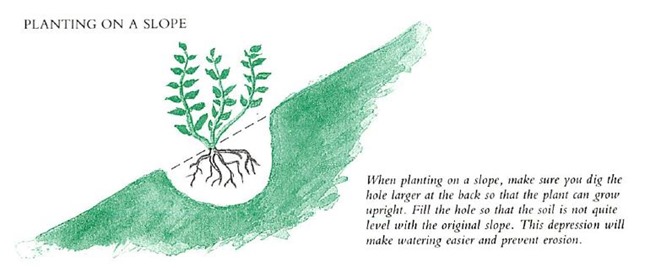





Should your garden be on a slope it does not necessarily mean you will be planting on a slope, as the garden may be terraced and have retaining walls. But planting on a slope is slightly more difficult and requires a different technique from planting on the flat.
The main rule is to cut into the back of the hill and make the part of the hole which is furthest uphill twice as deep. Try not to disturb the soil more than you have to, otherwise when it rains the loose earth will slip away. So make your hole so that when you place the plant in it both the front and back of the plant fit snugly in the space. Then firm down the earth around the plant on all sides. If only the back of the plant is in the hole, the roots in the front will not be properly covered and will dry out; it will be very hard for the plant to get established, and it may never succeed.
Another big problem with plants growing on a slope is the difficulty in watering them properly. Water tends to run off a slope very quickly, so when it rains plants don’t have the nice soaking they would normally have. Adding 3-4in (7.5-10cm) of mulch helps to retain the moisture.
The soil on some banks is very well drained. If you have a well-drained, sunny slope, choose plants that like well-drained soil, such as many hard herbs (rosemary, sage, thyme). Most alpines which grow well in a rock.garden like well-drained soil. On banks of this kind you already have the conditions of a rock garden for alpines without having to go to the trouble and expense of making one. By strategically placing the odd stone in a niche dug out for it between the plants, you will create the impression of a rock garden. Try to pack stone chipping between the plants until they get established, to keep out the weeds.

I had a number of difficult banks to cope with in my two-acre field conversion and I eventually resorted to variegated periwinkle and ivy. This I was advised was fine for a small bank but rather dull on a large bank. As the soil was very acid, the bank was ideal for a feature such as dwarf evergreen azaleas, top-dressed with a good mulch to keep in the moisture which azaleas badly need. I only saw the bank after the azaleas were planted for one spring, but for those few weeks in late spring it was sensational. Many of the good ground cover plants have exciting leaves and make excellent planting for slopes, with their dense root system and rapidly growng suckers. Hypericum calycinum, which has bright yellow star flowers in summer, is excellent for the job. It spreads well, holds the soil together and keeps the weeds out. Sedum spurium ‘Ruby Glow’ and Saxifraga umbrosa are also among the many plants suitable for slopes.
If you have to cope with a damp shady bank and you don’t want ivy or periwinkle, try bergenias. Plant them at the top of the slope – they will soon cover the surface as their rhizome roots creep down the slope. Banks and slopes are not easy but can look very effective; if you plant correctly, the plants will live as happily there as anywhere else.
Copyright © www.100flowers.win Botanic Garden All Rights Reserved